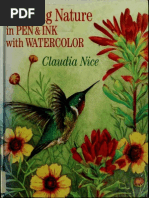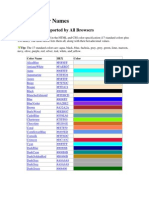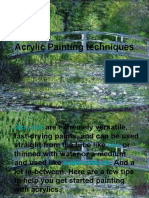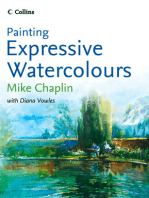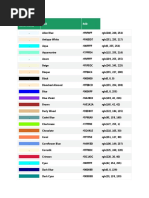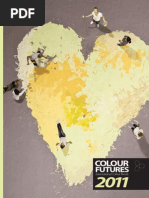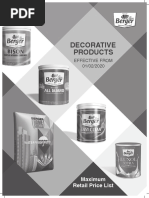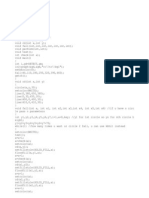Acrylic Painting Techniques: Methods On How To Paint With Acrylics For Acrylic Landscape Painting and Interiors
Acrylic Painting Techniques: Methods On How To Paint With Acrylics For Acrylic Landscape Painting and Interiors
Uploaded by
Ravin Taira PalCopyright:
Available Formats
Acrylic Painting Techniques: Methods On How To Paint With Acrylics For Acrylic Landscape Painting and Interiors
Acrylic Painting Techniques: Methods On How To Paint With Acrylics For Acrylic Landscape Painting and Interiors
Uploaded by
Ravin Taira PalOriginal Description:
Original Title
Copyright
Available Formats
Share this document
Did you find this document useful?
Is this content inappropriate?
Copyright:
Available Formats
Acrylic Painting Techniques: Methods On How To Paint With Acrylics For Acrylic Landscape Painting and Interiors
Acrylic Painting Techniques: Methods On How To Paint With Acrylics For Acrylic Landscape Painting and Interiors
Uploaded by
Ravin Taira PalCopyright:
Available Formats
presents
ACRYLIC
PAINTING
TECHNIQUES
Methods on
How to Paint with Acrylics
for Acrylic Landscape
Painting and Interiors
2 www.artistdaily.com
ACRYLIC PAINTING
TECHNIQUES
This content has been abridged from an original article written by M. Stephen Doherty. F+W Media, Inc. All rights reserved.
F+W Media grants permission for any or all pages in this premium to be copied for personal use.
Compose & Paint
Varied Landscapes With Acrylics
When Jeanette Chupack moved from Vermont to Florida and
became an avid kayaker, she had to adapt her acrylic-painting
procedures to respond to the complicated, repetitive patterns
she observed along the waterways of the Sunshine State.
by M. Stephen Doherty
Rounding the Bend
2009, acrylic, 20 x 30.
This painting won first prize in the acrylic category of the American Artist/Utrecht painting
contest in 2009. All images this article collection the artist unless otherwise indicated.
3 www.artistdaily.com
ACRYLIC PAINTING
TECHNIQUES
It took Jeanette Chupack a couple of
years to adjust to the landscapes she
observed while kayaking along the
waterways near her home in Cape
Coral, Florida. The new locales were
quite different from the rolling land-
scapes she used to observe and paint
in Vermont. The Florida landscape
presents its own challenges because
it is flat, filled with wildlife and tropi-
cal plants, and saturated with moist
atmosphere during most of the year,
Chupack explains. I was excited about
discovering the scenery, especially as
my husband and I spent more time
kayaking along the network of water-
ways. It took me two years to develop a
good painting from the images logged
Sparkling Waters
2008, acrylic, 8 x 10.
Private collection.
in my mind. I had to find a way of
seeing the spaces and vegetation in a
completely different way, and I had to
consider a new approach to composing
the elements into acrylic paintings.
About the same time Chupack
moved her studio, she changed from
using photographic film to digital
memory cards in her camera. Ive
always used photographs as a key piece
of source material, but in the past I
relied on slides and prints to catalog
potential images, and I had to adjust
for the differences between what I
remembered and what the film and
processing presented. With digital
photography, I have instantaneous and
complete control over the informa-
4 www.artistdaily.com
ACRYLIC PAINTING
TECHNIQUES
tion recorded on the spot. I bought a
waterproof Pentax camera I could use
while kayaking, and now I immediately
review the photographseven the ones
I take underwater.
Chupack also bought an LCD projec-
tor so that she can enlarge the full or
detailed digital photographs when she
wants to refer to them while painting.
The projector also allows her to trace
the images directly on to her gessoed
canvas using a graphite pencil. The
landscape is often a densely compacted
display of repeated colors, shapes, and
patterns, so I start with one photograph
and then adjust the projected draw-
ing to get a stronger, more focused
composition, she explains. I may
have to take elements from five or six
photographssome detail shots, some
wide-angle viewsin order to have
one center of interest and a hierarchy
of supportive shapes and colors. I look
for those kinds of elements as I move
along a river so that I have enough
information when Im painting in my
studio.
The light is very important in a
landscape, and I may pass a location
hundreds of times before the pattern
of light and shadow makes it visually
appealing, Chupack continued. As
soon as I see that kind of pattern, I take
lots of photographs because I know
it will help in adding interest to what
might otherwise be an average scene.
Back in my studio, I play around with
the digital image in the computer by
changing the colors or levels of con-
trast or by cropping, using the editing
options in Photoshop or Picasa. My
biggest challenge is usually trying to
ABOVE
Lady Slipper
Orchids
2006, acrylic,
13
1
2 x 10
1
2.
LEFT
Stepping Out
2009, acrylic,
33 x 42.
5 www.artistdaily.com
ACRYLIC PAINTING
TECHNIQUES
simplify and focus the composition.
It is important for artists to work
from life so that they can bring an
in-depth understanding to their inter-
pretations of photographs, Chupack
insists. Photographs flatten the spaces
and distort colors and values, and
unless one has drawn and painted from
life, he or she wont know how to com-
pensate for those distortions. Before
I could ever work from photographs
I put in years of time working on-site
from still life arrangements and from
the figure. In fact, I ran a life-drawing
class every week for about 15 years
when I was living in Vermont.
Once Chupack is satisfied with
the edited photograph and has the
basic outline of the forms projected
and traced on the canvas, she begins
building up layers of acrylic paint.
I stretch and prepare the canvases
Grand Old Cypress
of Prairie Creek
2007, acrylic, 20 x 30.
myself by sealing them with several
layers of acrylic gesso mixed with a
small amount of yellow ochre to give
the painting surface an off-white tone,
she explains. When the surface of the
canvas is dry, I secure it into one of two
Richeson easels I have in my studio
one handles small paintings and the
other can hold big ones.
I apply a coat of retarder over the
entire canvas to slow the drying time
of the paint, and then I block in all the
areas of the picture with an approxima-
tion of the local colors so that I can
quickly assess the strength of the com-
position, Chupack says. Continuing
with Golden heavy-body acrylic paints,
I focus on building up the layers from
the background shapes to those in the
foreground. The exception to that pro-
gression is when there is a large body
of water in the painting and I need to
6 www.artistdaily.com
ACRYLIC PAINTING
TECHNIQUES
block that in fairly early in the paint-
ings development so that I can judge
the balance of colors and values. I
always avoid getting caught up in paint-
ing details because I have to make sure
the picture holds together before I start
fussing over details or applying glazes
of tone.
Chupack says she does a lot of glaz-
ing with Golden or Utrecht brands of
paint thinned with semigloss soft gel
medium. I layer closely related colors
and values, not
complimentary colors, she says. Its
my way of unifying the brushwork of
the fast-drying acrylic paint that has a
tendency to look fractured and dull if
it isnt adjusted. Layering and glazing
give the painting more resonance and
depth of color. I use synthetic brushes
for most of the painting process, but
I do switch to bristle brushes when I
want to push the paint harder when
painting something like clouds, or I
use sable brushes when I want to add
linear details. I also have a fan brush
available for painting grass and one
giant sable brush I can use for painting
big areas quickly.
Chupack says she usually has four
or five paintings in her studio that are
in various stages of development, but
once she has a clear vision of how a
painting needs to be completed she
will concentrate on that one image
until it is resolved. I tend to concen-
trate on a painting until I finish it,
and then I sketch ideas for several
other paintings on stretched, toned
canvases, she explains. I may leave a
work unfinished for as much as a year
before I decide what it needs. I seldom
Clear Day, Prairie Creek
2008, acrylic, 20 x 30.
7 www.artistdaily.com
ACRYLIC PAINTING
TECHNIQUES
Telegraph
Creek Oak
2008, acrylic,
30 x 20.
8 www.artistdaily.com
ACRYLIC PAINTING
TECHNIQUES
give up on a painting and like the fact
that acrylic allows me to quickly make
changes without having to wait days
and weeks for the layers of paint to dry
thoroughly.
Once her paintings are completed,
Chupack applies a coat of high-gloss
medium over the entire surface unless
the canvases are especially large. I like
to add a layer of protection, and I find
collectors are more receptive to paint-
ings with a glossy finish because they
are accustomed to looking at oil paint-
ings, she explains. If the canvas is
really large, I use a semigloss medium
over the surface because high-gloss
finishes often create so much glare that
it is difficult to see the entire image at
one time.
Chupack sells her
paintings through com-
mercial galleries and her
gicle prints on the inter-
net. The prices for original
paintings range from
$500 to $900 for small
(8-x-10), unframed can-
vases up to $7,000 for a
40-x-60 unframed paint-
ing. Her prints sell from
$40 for an 8-x-10 image
up to $250 for a 20-x-30
print. Some of her prints
have recently been published as part of
fund-raising programs sponsored by
environmental groups. n
ABOVE
Green Turtle
2008, acrylic, 33 x 42.
Private collection.
TOP
Osprey Nest in
Florida Bay
2009, acrylic, 17 x 22.
9 www.artistdaily.com
ACRYLIC PAINTING
TECHNIQUES
Still Life for a Summer Afternoon
2007, acrylic, 40 x 60.
ABOUT
THE ARTIST
Jeanette Chupack earned a B.F.A.
from Syracuse University, in New
York, and an M.F.A. from Indiana
University, in Bloomington, and
she attended the Yale Summer
School of Music and Art, in
Connecticut. She taught at a
number of institutions, includ-
ing the University of Vermont, in
Burlington, and she has conducted
painting workshops. She currently
maintains a studio in Cape Coral,
Florida. For more information, visit
www.jchupackart.com.
10 www.artistdaily.com
ACRYLIC PAINTING
TECHNIQUES
The rooms inside private homes, his-
torical museums, and public buildings
make excellent subjects because they
give artists the chance to create interest-
ing relationships between adjoining
rooms, reflective windows and mir-
rors, contrasting natural and artificial
light, and organized furnishings. The
cool light from a table lamp in a living
room can be shown close to the warm
sunlight of a nearby kitchen. A heavy
Victorian sofa can be balanced by a
delicate spindle-backed chair. And a six-
foot hall mirror can reflect the images
of people sitting in an adjacent room.
All of these possibilities can be explored
in paintings derived from
photographs, drawings, or
on-site studies of interiors.
Ronald Lewis became
interested in painting
interiors when he began
to grow bored with the oil landscapes
he had been producing for a number
of years. I was getting burned out, he
explains. And even though I loved the
smell of oils, I felt I could really take
advantage of the fact that acrylics dry
so much faster. I decided to focus on
acrylic paintings of interiors, a subject
I had explored on occasion but never
really focused on. I quickly discovered
a whole range of possibilities with the
subject and the medium.
Lewis is one of many artists who
have added acrylics to their repertoire of
painting mediums. While oil paints and
varnishes have qualities that cant be
Beginner Painting Tips
Learn acrylic painting in 7 steps. by M. Stephen Doherty
This content has been abridged from an original article written by M. Stephen Doherty. F+W Media, Inc. All rights reserved.
F+W Media grants permission for any or all pages in this premium to be copied for personal use.
Game Room,
Sims House,
1996, acrylic,
14 x 10. Private
collection.
Artist Daily Step-by-Step
11 www.artistdaily.com
ACRYLIC PAINTING
TECHNIQUES
matched by other paints,
they dry slowly and re-
quire the use of mineral
spirits, turpentine, or
other potentially hazard-
ous solvents and mediums. Acrylic
paints are mixed with water and can
be altered with water-based acrylic me-
diums and additives to increase their
thickness, extend their drying time,
and modify their finish. Furthermore,
acrylics dry quickly and permanently,
making it possible to paint additional
layers of color over them within a mat-
ter of minutes.
Lewis came up with the idea of
painting interiors while visiting the
homes of friends in Birmingham,
Alabama, where he lives. He asked to
take photographs and make sketches of
the rooms and later used that mate-
rial in his paintings. Once he decided
to create more such works, the artist
made a trip to the historical town of
Eufaula, Alabama, which, because of its
position on the Chattahoochee River,
once prospered from the riverboats
that passed on the way to the Gulf of
Mexico. Wealthy families built large,
ornately appointed homes there that
Lewis now finds to be excellent subject
matter. The paintings shown in this
article depict rooms in one of the
artists favorite homes in Eufaula, the
Sims house.
Even though he begins his paint-
ings by referring to photographs
and sketches of actual rooms, Lewis
changes things so radically that the
paintings seldom end up looking
like the actual locations. One of the
advantages of acrylics is that as long as
I keep the paint relatively thin during
the initial stages, I can make whatever
changes I want, the artist explains.
I can add and subtract furniture,
re-create the framed pictures on the
walls, and change the colors and pat-
terns in the room with no problems.
I once turned a canvas on its side and
converted a horizontal picture into a
vertical one.
Sometimes Lewis paints on
watercolor paper, watercolor board,
or Masonite, but about half his acrylic
Guest Room,
Sims House
1996, acrylic,
14 x 10. Private
collection.
paintings are done on Fredrix acrylic-
primed canvas. The acrylic paints are
versatile enough to also be applied to
wood, paper, or certain plastic panels.
Beginning with thin applications
of paint and later switching to thicker,
more opaque brushstrokes, Lewis takes
advantage of the fact that most manu-
facturers of acrylic paints sell both
a fluid and a thick formulation. The
12 www.artistdaily.com
ACRYLIC PAINTING
TECHNIQUES
fluid colors are usually sold in jars or
squeeze bottles, making it convenient
to work with thin paint. The thicker
formulations are usually available in
standard paint tubes or in jars. Lewis
palette normally includes the following
colors: titanium white, burnt umber,
burnt sienna, yellow oxide, raw sienna,
cadmium orange, cadmium yellow,
Hookers green, dioxazine purple,
Grumbachers alizarin crimson, cad-
Guest Room, Sims House
(Second Impression)
1996, acrylic, 14 x 10.
This painting and the one on the
previous page show the same
interior, and show the diversity of
Lewis approach to acrylic painting.
He sometimes prefers a loose,
gestural style rather than a tight,
detailed presentation.
of acrylic gloss medium, which brings
out some of the underlying colors and
gives the picture the glossy surface of
an oil painting.
The artist sells most of his paint-
ings through commercial galleries, but
he also exhibits in a few national and
regional outdoor festivals. Most of my
sales occur in the spring and fall, so I
try to get my work out as much as pos-
sible during those times of the year, he
explains. The best outdoor shows are
usually the ones that are juried, and its
a good idea to exhibit in the same show
for several years in a row so collectors
can become familiar with your work.
Lewis graduated from Alabama
College (now the University of Monte-
vallo) in 1967. He has received nearly
100 awards for his oil, watercolor, and
acrylic paintings in juried shows orga-
nized by the American Watercolor So-
ciety, Watercolor U.S.A., the Southern
Watercolor Society, Arts for the Parks,
and other national organizations. He
has illustrated two books, My Country
Roads and Papas Old Trunk (both Buck
Publishing Company, Birmingham,
Alabama). Lewis paintings have been
featured in Southern Accents and are in
many private and corporate collections
as well as in those of the Birmingham
Museum of Art and the Fine Arts Mu-
seum of the South in Mobile, both in
Alabama, and the Columbus Museum,
in Georgia. n
mium red, and Mars black.
During some phases of a paintings
development, the artist may add Gold-
ens acrylic retarder to thin the paints
and slow the drying process. This step
is particularly important when he is try-
ing to establish a subtle blend of colors
or a soft transition between adjacent
tones and needs to keep the paint from
drying too quickly. But once a painting
has been completed, he applies a coat
TURN THE PAGE FOR A
STEP-BY-STEP
13 www.artistdaily.com
ACRYLIC PAINTING
TECHNIQUES
Demonstration:
Reading Chair, Sims House
Continued...
Step 1
After making a
rough graphite
drawing on acryl-
ic-primed canvas,
Lewis applied a
thin underpainting
of burnt sienna
and burnt umber.
Step 2
He then blocked
in the walls with
cadmium orange,
yellow oxide, and
titanium white.
Step 3
The fireplace and
hanging pictures
were then painted
with Hookers
green and yellow
oxide. He toned
the picture down
with dioxazine
purple and tita-
nium white.
Step 4
Next, Lewis
painted the
chair. He added
some Goldens
acrylic retarder
to increase the
drying time of the
paint so he could
blend details
before the paint
dried.
1 2
3 4
14 www.artistdaily.com
ACRYLIC PAINTING
TECHNIQUES
Reading Chair, Sims House
1996, acrylic, 18 x 14.
Courtesy Bryant Galleries,
Jackson, Mississippi, and
New Orleans, Louisiana.
Step 5
This detail shows how Lewis
used a white charcoal pen-
cil to draw the table and
books more carefully before
painting them.
Step 6
Finally, he blocked in the
bed and rug using blue,
red, purple, and burnt
umber with titanium white.
5
6
15 www.artistdaily.com
ACRYLIC PAINTING
TECHNIQUES
This content has been abridged
from an original article written by
Karyn Meyer-Berthel. F+W Media,
Inc. All rights reserved. F+W Media
grants permission for any or all
pages in this premium to be copied
for personal use.
Diligent
by John Garrison,
2007, acrylic, 48 x 36.
Private collection.
Acrylic Artists
Share Methods, Materials,
and Techniques by Karyn Meyer-Berthel
5
16 www.artistdaily.com
ACRYLIC PAINTING
TECHNIQUES
JOHN GARRISON
Chicago artist and illustrator John Garrison uses
acrylic paints and mediums because they behave
similarly to oils but dry much faster.
John Garrison has always been interested in architecture and
design. Because I am a graphic designer and illustrator, I am
attracted to the simplification and stylization of images, he says. I
admire both the Art Nouveau and Art Deco movements, and I am
enamored with the extant structures designed by architect Louis
Sullivan (18561924). Garrisons figure paintings incorporate
elements of Art Deco objects and architecture, and his subjects
are also portrayed in motion. I look for subjects that allow me
to convey a sense of movement and energy, he explains. I work
from photographic references, sometimes combining multiple
images in the final painting. If I could afford to use live models, I
would, but thats just not practical.
Acrylic is Garrisons preferred medium because he feels it
gives him more control over the painting process. Acrylics are
great because they can behave like oils but dry much faster, and
cleanup requires only waterplus, they dont fill the air with the
smell of solvents, he says. I use Liquitex acrylics because theyre
of a high quality, and I can count on their performance. The abil-
ity to trust his products is yet another way Garrison can exercise
Iron Cross
by John Garrison, 2007, acrylic,
24 x 48. Private collection.
17 www.artistdaily.com
ACRYLIC PAINTING
TECHNIQUES
control, which in turn allows him to work
more quickly. Because he knows how
his materials will behave, he can focus
solely on realizing his visionsomething
he likes to do as fast as possible. Im
impatient, so I often work with a brush
in one hand and a blow-dryer in the other
to speed up the drying process, the artist
explains. If I need to extend the drying
Convergence
by John Garrison, 2007,
acrylic, 36 x 36. Private
collection.
time of acrylics, I mix them with matte
medium. Although the paints normally
dry to a matte finish, I coat some areas
of the dry painting with gloss medium
so that the final piece has a visual play
between the two finishes.
For more information on Garrison, visit his website at
www.garrisonart.com.
18 www.artistdaily.com
ACRYLIC PAINTING
TECHNIQUES
LJ LINDHURST
Brooklyn artist LJ Lindhurst creates
large-scale paintings of everyday objects to
record details of our culture.
I am a photorealist painter, and I want my paintings to
present reality without an obvious style or embellishment,
says LJ Lindhurst. Because of that philosophy, I reproduce
the photographed image as accurately as possible. Form,
composition, and style occur naturally and are illuminated
by this neutral approach. Thats why I work from my own
photographs or images lifted from mass-media sources, such
as print advertising and television-screen shots.
Mack Truck Dog
by LJ Lindhurst, 2007,
acrylic, 36 x 36.
Collection the artist.
19 www.artistdaily.com
ACRYLIC PAINTING
TECHNIQUES
Thematically, the subjects of my
paintings are varied, Lindhurst adds. I
am attracted to macro views of totems
of popular culture such as toys, Easter
bunnies, chocolates, shiny metal locks,
dolls, and other seemingly innocu-
ous items. By closely examining these
otherwise ordinary images and render-
ing them several hundred times their
normal size, I can capture an unusual
sensuality and uneasy sense of comedy.
Other artists might consider this paint-
ing process to be tedious, but I find it to
be engrossing and quite relaxing. After
several hours work, I enter a meditative
state, and its in these moments that
I see subtleties in the colors, shading,
or tiny imperfections in the surface of
objects. Flat areas suddenly reveal a
more complex palette and details that
might otherwise be overlooked.
Lindhurst works with acrylic paints
diluted with small amounts of water
and Liquitex Flow Aid, which allows
her to control the opacity of the colors.
She also turns to Liquitex for paints,
although she likes blacks and whites by
Golden Artist Colors. When she wants
to create the illusion of depth, she
mixes paints with varnish or gloss gel
medium. I also use gloss gel medium
if I want to make one color more lumi-
nous, and in those situations I paint
several transparent layers of a color so
that it doesnt end up looking flat, she
explains. I use the traditional process
of working from dark to light values,
layering colors of varying opacities on
top of one another. A typical large-scale
painting can take anywhere from three
to six months to complete, although I
can sometimes finish a smaller or less
detailed piece in a matter of weeks.
For more information on Lindhurst, visit her website at
www.ljlindhurst.com.
Lock No. 3
by LJ Lindhurst, 2005, acrylic,
48 x 24. Collection the artist.
20 www.artistdaily.com
ACRYLIC PAINTING
TECHNIQUES
My work is concept-driven and focused primarily on natu-
ralistic subjects, says Oregon painter Dan Mandish. I work
from my own photographs, and from these I typically make
detailed drawings before I begin to paint. The artist works in
a variety of media and produces a substantial amount of work
in acrylic. Although acrylic paints dont require an artist to
adhere to the fat-over-lean or thick-over-thin dictum, Man-
dish employs these oil-painting techniques in his painting
process. However, he accommodates the fast drying time of
the acrylics by following strokes of paint with applications
of pure water. My preference is to work on smooth panels
DAN MANDISH
As a professional illustrator and graphic artist, Dan
Mandish uses a traditional thin-to-thick painting
technique, sometimes blending colors and softening
edges with a brush loaded with water.
The Diver
by Dan Mandish, 2006,
acrylic on board,
21 x 21. Courtesy
For Artsake Gallery,
Newport, Oregon.
coated with gesso ground and toned
with a middle-tone earth color such as
a combination of raw sienna and terra
rosa, he explains. I then block in the
images using thin washes of the darkest
colors and work up to the lightest val-
ues, gradually increasing the thickness
of the paint applications.
The exception I make with acrylic
is in blending colors, Mandish goes on
to say. I use two brushes, one loaded
with pigment and the other holding pure
water, so I can apply paint and then im-
mediately feather one value into another.
I experimented with adding acrylic
retarding mediums to slow the drying
time of acrylics and facilitate blending,
but I still find that working with the two
brushes gives me more control. The art-
ist uses sable or sable-synthetic brushes
in a wide variety of sizes.
I prefer Liquitex colors because Ive
used them from the start, Mandish
says. I know what to expect from
them, and Im intimately familiar with
the available color selections, including
which colors have high tinting strength,
which colors mix well to create neutrals,
and which are stiff when squeezed from
a tube. These variables differ consider-
ably between paint manufacturers.
For more information on Mandish, visit his blog at
http://saltandlighteditions.wordpress.com
21 www.artistdaily.com
ACRYLIC PAINTING
TECHNIQUES
DAAN HOEKSTRA
Daan Hoekstra, an artist based in Sonora,
Mexico, uses raw pigments mixed with acrylic
binders to create translucent murals on masonry.
Daan Hoekstra is a classically trained landscape, still life, and
figurative painter, and he received much of his training in
the atelier system under Richard Lack. During his time as a
student, Hoekstra began painting murals, working as a buon
fresco assistant for artist Mark Balma in the 1980s, and today
many of his commissions still come from mural work. He
Humanity at the
Crossroads
by Daan Hoesktra,
2008, acrylic, 24 x 90.
Courtesy Grand Rapids
Community Foundation.
22 www.artistdaily.com
ACRYLIC PAINTING
TECHNIQUES
considers his approach methodical, and
his choice of materials is determined
by what will increase the longevity of
his work. I try to use conservators
materials and processes when possible,
so I usually start with a coat of Lascaux
Hydro-Sealer to the masonry, Hoekstra
explains. Hydro-Sealer is a consolidant
for old masonry, but it is also recom-
mended by Lascaux to prepare surfaces
before applying the companys mural
primer. Because it is transparent, the
natural color of the masonry remains
visible, and I often use that as the
half-tone value in the mural. If I have
to block out some or all of the original
color of the wall, I use a translucent
white primer thinned with water.
Hoekstras experience using tradi-
tional fresco techniques made it easy for
him to switch to using modern acrylic
resins. When the halftone is established
on the wall, I lay in the darks transpar-
ently, using raw pigments mixed with
acrylic binder, he explains. I make
a paste of the pigments and distilled
water, and then I add an equal volume
of acrylic color. This mixture can then
be thinned with water, although the
pigment tends to sink to the bottom of
the paint bucket and must be stirred
with the brush each time I dip into it.
With a little practice, I learned to control
the concentration of the pigment in the
brush according to the amount of swish-
ing and the rate of settling.
After I have laid in the darks, I paint
the light-valued shapes with translucent
to opaque matte white acrylic, Hoeks-
tra adds. Then I finish the mural with
thin glazes that add color to the lights,
develop the halftones, and deepen the
darks. I operate on the assumption that
if the paint is allowed to soak into the
masonry (rather than sit on the surface)
it will be less likely to peel. For a final
varnish, I follow the specifications
provided by Golden Artist Colors and
apply an isolating coat of soft gel and a
UV-resistant clear varnish.
For more information on Hoekstra, visit his website at
www.hoekstrastudio.com.
La Quintera Mural
by Daan Hoesktra, 2008, acrylic,
18' x 40'. Courtesy the Municipal
Cultural Development Program,
Sonora, Mexico.
23 www.artistdaily.com
ACRYLIC PAINTING
TECHNIQUES
JEANINE LECLAIRE
Philadelphia artist Jeanine Leclaire chose
acrylic paints and mediums because she wanted
to have complete flexibility in designing her
pictures and expressing her concepts.
Like many artists, Jeanine Leclaire works from photographs
but doesnt allow them to define her final work. The end
results have to stand as works of art without regards to the
photographic sources, she says. I focus on everyday mo-
ments, with an emphasis on those that conjure emotional
Jewel
by Jeanine Leclaire
2008, acrylic, 32 x 24.
Private collection.
24 www.artistdaily.com
ACRYLIC PAINTING
TECHNIQUES
responses.I often paint my husband,
friends, and their surroundings because
those make up my life. I keep my
camera handy and photograph people
and places without telling people how
to pose or what objects to have in the
shots. As I am taking the photographs I
consider composition and content, but
I do so with the knowledge that I can
alter anything I want when Im paint-
ing.The final decision for what I use
is made after I print the photos.Ill lay
them all out and choose the ones that
speak to me. Ill also use other photos
to add to the one Ive chosen, and
sometimes even bits from the media,
and my imagination will make its way
into my paintings.
After I decide what I will paint, I
draw directly onto the gessoed wood
panel and establish the foundations for
the composition, Leclaire goes on to
explain. After I start painting, I remain
flexible and move things around be-
cause some aspects of the picture wont
reveal themselves until I am halfway
through the painting process.Next, I
block in the shadows with black, add
Fragile
by Jeanine Leclaire
2009, acrylic, 6 x 5.
Collection the artist.
the highlights with white or light colors,
and then move the paint around until it
looks right to me.Decisions are made
as much in response to my feelings as
to anything else. Leclaire uses a palette
of professional-grade Utrecht acrylics
that includes cadmium red extra deep,
cadmium red medium, cadmium
yellow, ultramarine blue, brilliant blue,
ivory black, and titanium white. n
For more information on Leclaire, visit her website at
www.jeanineleclaire.com.
Top Resources for Artists pppppp
IMPROVE YOUR PAINTING SKILLS !
Learn painting essentials from popular art instructor
Johannes Vloothuis, as he shares his simple, effective
approach for painting a variety of landscape elements.
Johannes has taught thousands of students in work-
shops and online courses and can help you become
a better artist, no matter your medium or skill level.
Expand your knowledge, overcome those obstacles,
improve your skills and create better paintings now!
JOIN JOHANNES LIVE ONLINE!
Visit ArtistsNetwork.com/WetCanvasLive
to register or for more information.
Limited seating is available for each seminar.
Brought to you by the publishers of North Light Books and ArtistsNetwork.com
I struggled for years
with composition,
value, color harmony,
etc. Then I stumbled
upon your Wet
Canvas Webinar and,
presto, within weeks
things just clicked.
You have given me
the tools to create
and blossom. Thank
you ever so much!
Shirley
ONLINE ART COURSES
WITH JOHANNES VLOOTHUIS
Live!
2011 ANNUAL CD
from YOUR
FAVORITE ART
MAGAZINES!
Te Artists Magazine
Item #U4690
Watercolor Artist
Item #U4692
Te Pastel Journal
Item #U4691
Southwest Art
Item #U4743
Your #1 Resource for Online Video
Art Instruction!
Learn tips and techniques from the best art
instructors in the comfort of your home! With
over 200 videos available in your favorite mediums
(and a new video added each week) were sure
theres something for you!
SPECIAL OFFER!
Visit www.artistsnetwork.tv to join now and
SAVE 10% on any subscription option!
Use coupon code ATVMAG2013A
HURRYthis is a limited-time offer, so subscribe today.
ART WORKSHOPS
ON DEMAND
Top artists share their secrets!
Artists Network University is your destination
for online education, offering ne art online
courses for artists of all skill levels. Artists Network
University offers art classes online in four-week,
instructor-guided classes that meet on the web.
Youll receive personal guidance from well-
known workshop instructors in a variety of drawing
and painting mediums. Learn to be a better artist
on your own schedule with:
Proven techniques from experienced art
instructors
Classes taken in the comfort of your home
New courses added each week
I MPROVE YOUR ART TODAY!
REGI STER NOW AT
artistsnetworkuniversity.com!
unvrasvv
ES! ES!
Available online at
NorthLightShop.com
or call 1-855-842-5267 to order.
al
You might also like
- Watercolour Secrets Ebook PDFDocument61 pagesWatercolour Secrets Ebook PDFMarcos Junior91% (11)
- Watercolour Secrets Ebook PDFDocument61 pagesWatercolour Secrets Ebook PDFMarcos Junior91% (11)
- Oil Painting Cheat SheetsDocument28 pagesOil Painting Cheat SheetsVictor Sorin Ploscaru100% (7)
- Impressionist Painting For The Landscape - Secrets For Successful Oil Painting (gnv64) PDFDocument147 pagesImpressionist Painting For The Landscape - Secrets For Successful Oil Painting (gnv64) PDFCristian Lemus Borja100% (10)
- Acrylic Painting: The Ultimate Crash Course To Acrylic Painting - Discover the Art of Acrylic Painting for Still LifeFrom EverandAcrylic Painting: The Ultimate Crash Course To Acrylic Painting - Discover the Art of Acrylic Painting for Still LifeRating: 4 out of 5 stars4/5 (7)
- Acrylic Secrets EbookDocument92 pagesAcrylic Secrets Ebookrazan_ay100% (2)
- Brilliant ColorDocument146 pagesBrilliant ColorSimón Simón100% (12)
- Painting in Oil by The 5-Color MethodDocument256 pagesPainting in Oil by The 5-Color MethodBeetheArtist Timeline100% (9)
- Oil Painting For Beginners.Document5 pagesOil Painting For Beginners.Desdemona100% (3)
- Acrylic Painting Step by StepDocument66 pagesAcrylic Painting Step by StepCarlo Di Domenico95% (22)
- All I Know About PaintingDocument167 pagesAll I Know About PaintingJohn Warren Oakes100% (4)
- The Watercolour Artist S HandbookDocument228 pagesThe Watercolour Artist S Handbookmr mxyzptlk98% (46)
- Painting - DK Art School - Ray Smith - Watercolor Color (1993)Document76 pagesPainting - DK Art School - Ray Smith - Watercolor Color (1993)fabritte98% (46)
- Getting Started With Oil PastelsDocument7 pagesGetting Started With Oil PastelsPapy Rys69% (13)
- Claudia Nice Painting Nature in Pen and Ink With WatercolorDocument136 pagesClaudia Nice Painting Nature in Pen and Ink With WatercolorStaska Kolbaska96% (45)
- Colors Hexadecimal ValuesDocument5 pagesColors Hexadecimal ValuesVijai RagavNo ratings yet
- 03 WN Artists Oils Color Chart 49Document1 page03 WN Artists Oils Color Chart 49Jose ValenzuelaNo ratings yet
- Ames' Guide To Self-Instruction in Practical and Artistic PenmanshipDocument63 pagesAmes' Guide To Self-Instruction in Practical and Artistic Penmanshiphoudoken100% (17)
- 1239 Budapest, Grassalkovich Út 255. Tel.: 284-2382, 2841752 Fax.: 289-0457Document1 page1239 Budapest, Grassalkovich Út 255. Tel.: 284-2382, 2841752 Fax.: 289-0457Jovica TadićNo ratings yet
- Sea & Sky in Acrylics: Techniques & InspirationFrom EverandSea & Sky in Acrylics: Techniques & InspirationRating: 5 out of 5 stars5/5 (5)
- Painting Successful Watercolours from PhotographsFrom EverandPainting Successful Watercolours from PhotographsRating: 5 out of 5 stars5/5 (5)
- How To PaintDocument196 pagesHow To PaintCristian Zhino Olivares A100% (20)
- How To PaintDocument125 pagesHow To PaintFabio Nagual75% (8)
- Acrylic BookDocument122 pagesAcrylic BookDaniel Musat100% (1)
- Bell - Angelina Oil Painting - Learn Oil Painting FAST - Learn The Basics of Oil Painting in No Time - 2 PDFDocument99 pagesBell - Angelina Oil Painting - Learn Oil Painting FAST - Learn The Basics of Oil Painting in No Time - 2 PDFmido100% (6)
- Acrylic Painting TechniquesDocument28 pagesAcrylic Painting Techniquesadeladly2000No ratings yet
- Acrylic Tips For BeginnersDocument4 pagesAcrylic Tips For Beginnerssneha100% (2)
- ArtistsNetwork AcrylicPainting 2016Document16 pagesArtistsNetwork AcrylicPainting 2016Gabo González86% (7)
- Oil Painting Materials Made EasyDocument18 pagesOil Painting Materials Made Easyternpfl100% (1)
- Number 1 Way To Improve Your Artwork Acrylics EdDocument67 pagesNumber 1 Way To Improve Your Artwork Acrylics Edkkant7889% (9)
- Painting The Impressionistic Landscape Exploring Light and ColorDocument206 pagesPainting The Impressionistic Landscape Exploring Light and ColorUm pouco de Mel100% (5)
- The Number 1 Way To Improve Your Artwork Oils EditionDocument76 pagesThe Number 1 Way To Improve Your Artwork Oils Editionkkant78100% (12)
- Acrylic PaintingDocument6 pagesAcrylic Paintingamlc5100% (4)
- Number 1 Way To Improve Your Artwork Acrylics Ed PDFDocument67 pagesNumber 1 Way To Improve Your Artwork Acrylics Ed PDFricardo100% (2)
- Acrylics WorkbookDocument29 pagesAcrylics WorkbookEvelina Anileve89% (9)
- Mastering The Craft of Painting (1985)Document152 pagesMastering The Craft of Painting (1985)gfgfghdf100% (10)
- Artist 39 S Color ManualDocument194 pagesArtist 39 S Color ManualVid100% (11)
- Acrylic Fusion - Experimenting With Alternative Methods For Painting, Collage, and Mixed MediaDocument129 pagesAcrylic Fusion - Experimenting With Alternative Methods For Painting, Collage, and Mixed MediaFabio Nagual100% (11)
- The Art of Oil PaintingDocument145 pagesThe Art of Oil PaintingMohammed Salih100% (10)
- Oil Painting WorkshopDocument131 pagesOil Painting Workshopfrancisc05996% (27)
- The Art of Acrylic PaintingDocument145 pagesThe Art of Acrylic Paintingdanhorgan100% (8)
- Watercolor SecretsDocument60 pagesWatercolor Secretsmissdoisneau98% (48)
- Mediums For Oil PaintingDocument24 pagesMediums For Oil PaintingDanila Ion Radu100% (2)
- Painting Lesson BookDocument96 pagesPainting Lesson Bookmarci12345100% (5)
- Mastering The Watercolor WashDocument144 pagesMastering The Watercolor Washdimmo100% (44)
- Gouache Acrylic Painting TechniquesDocument3 pagesGouache Acrylic Painting TechniquesCraig0% (1)
- Oil & Acrylic Workshop: Classic and Contemporary Techniques for Painting Expressive Works of ArtFrom EverandOil & Acrylic Workshop: Classic and Contemporary Techniques for Painting Expressive Works of ArtRating: 5 out of 5 stars5/5 (2)
- 101 Top Techniques for Artists: Step-by-step art projects from over a hundred international artistsFrom Everand101 Top Techniques for Artists: Step-by-step art projects from over a hundred international artistsRating: 5 out of 5 stars5/5 (1)
- Skin Tones in Oil: 10 Step by Step Guides from Old Masters: Learn to Paint Figures and Portraits via Oil Painting DemonstrationsFrom EverandSkin Tones in Oil: 10 Step by Step Guides from Old Masters: Learn to Paint Figures and Portraits via Oil Painting DemonstrationsRating: 5 out of 5 stars5/5 (2)
- Anyone Can Paint: Create sensational art in oils, acrylics, and watercoloursFrom EverandAnyone Can Paint: Create sensational art in oils, acrylics, and watercoloursNo ratings yet
- No Need for an Easel or a Mahl Stick: Oil Painting for the Absolute Beginner Made SimpleFrom EverandNo Need for an Easel or a Mahl Stick: Oil Painting for the Absolute Beginner Made SimpleNo ratings yet
- PRCDocument1 pagePRCRavin Taira PalNo ratings yet
- Transits in Vedic AstrologyDocument1 pageTransits in Vedic AstrologyRavin Taira PalNo ratings yet
- Foreign TravelDocument2 pagesForeign TravelRavin Taira PalNo ratings yet
- Rahu AspectDocument1 pageRahu AspectRavin Taira Pal100% (1)
- D30 OverviewDocument1 pageD30 OverviewRavin Taira PalNo ratings yet
- Malavaya YogaDocument1 pageMalavaya YogaRavin Taira PalNo ratings yet
- Planets2 12Document1 pagePlanets2 12Ravin Taira PalNo ratings yet
- An Open Letter by A Cop To Those Opposing Death Penalty To YakubDocument4 pagesAn Open Letter by A Cop To Those Opposing Death Penalty To YakubRavin Taira PalNo ratings yet
- Feb 2015 Electricity BillDocument1 pageFeb 2015 Electricity BillRavin Taira PalNo ratings yet
- Excel 2013 - PivotTables and Macros - studentFINALDocument68 pagesExcel 2013 - PivotTables and Macros - studentFINALabesneNo ratings yet
- Retro JupiterDocument1 pageRetro JupiterRavin Taira PalNo ratings yet
- Jupiter Starts It Effect at 40 Yr and 10 House From Its Placement Becomes EffectiveDocument1 pageJupiter Starts It Effect at 40 Yr and 10 House From Its Placement Becomes EffectiveRavin Taira PalNo ratings yet
- Rahu Aspect: TH TH TH TH THDocument1 pageRahu Aspect: TH TH TH TH THRavin Taira PalNo ratings yet
- Jup Sat ConjunctionDocument1 pageJup Sat ConjunctionRavin Taira PalNo ratings yet
- Saturn EffectDocument1 pageSaturn EffectRavin Taira PalNo ratings yet
- Indemnity Bond For Title TransferDocument1 pageIndemnity Bond For Title TransferHatakesh PotnuruNo ratings yet
- Advance Predictive Techniques of Ashtakvarga PDFDocument7 pagesAdvance Predictive Techniques of Ashtakvarga PDFAdityaKumar25% (4)
- Fin AstroDocument1 pageFin AstroRavin Taira PalNo ratings yet
- HOUSE 2 - Family, Fixed Assets, Speech, Family: TH ND THDocument1 pageHOUSE 2 - Family, Fixed Assets, Speech, Family: TH ND THRavin Taira PalNo ratings yet
- HOUSE 3 - Short Distance Travel, Like State ToDocument1 pageHOUSE 3 - Short Distance Travel, Like State ToRavin Taira PalNo ratings yet
- Nama WarnaDocument7 pagesNama Warnagaya tvNo ratings yet
- AkzoNobel Color Futures 2011 PDFDocument77 pagesAkzoNobel Color Futures 2011 PDFmistral14No ratings yet
- Paper Tube SculpturesDocument8 pagesPaper Tube Sculpturesapi-504812656No ratings yet
- Secondary Colors in Arabic and EnglishDocument23 pagesSecondary Colors in Arabic and EnglishKUNNAMPALLIL GEJO JOHNNo ratings yet
- C1RCA Look Book Spring 2010 MainlineDocument20 pagesC1RCA Look Book Spring 2010 Mainlinec1rca_modeNo ratings yet
- Color SchemesDocument7 pagesColor SchemesCristian BujorNo ratings yet
- Color WheelDocument1 pageColor WheelscribdhundmNo ratings yet
- TFT 2.8 - QuickGuide - Guia Rapida - Guide RapideDocument4 pagesTFT 2.8 - QuickGuide - Guia Rapida - Guide RapidegianfrancoNo ratings yet
- Listado de Filamentos Vendidos Por SunluDocument2 pagesListado de Filamentos Vendidos Por SunluUriel MendozaNo ratings yet
- Catalog Schneider 2015Document104 pagesCatalog Schneider 2015Cotoranu CiprianNo ratings yet
- Chemical Industry SME All India DataDocument385 pagesChemical Industry SME All India DataSenthil KumarNo ratings yet
- Oil PaintingDocument4 pagesOil Paintingsaur028No ratings yet
- ALV - CoresDocument7 pagesALV - Coresjnilson71No ratings yet
- Chroma Australia Product Catalogue 2019 LR PDFDocument56 pagesChroma Australia Product Catalogue 2019 LR PDFAungKyawOoNo ratings yet
- Ral Colour ChartDocument3 pagesRal Colour Chartreview20No ratings yet
- Tarifa Q2 SS17 KidsDocument74 pagesTarifa Q2 SS17 KidsFrancisca SuárezNo ratings yet
- Products Price List - Retail - Non - XP - February - 2020 PDFDocument24 pagesProducts Price List - Retail - Non - XP - February - 2020 PDFRahul GantaNo ratings yet
- Mind O MeterDocument5 pagesMind O MeterSaksham AgrawalNo ratings yet
- RAL ColorsDocument4 pagesRAL ColorsMilan SjausNo ratings yet
- Lista Preturi Alfaparf RO 2010 IanDocument7 pagesLista Preturi Alfaparf RO 2010 Ianmilogu69No ratings yet
- RUBENS'S The Gerbier Family Technical Examination of The Pigments and Paint LayersDocument22 pagesRUBENS'S The Gerbier Family Technical Examination of The Pigments and Paint LayersNyannnNo ratings yet
- Productivity Rate Interior Painting PDFDocument5 pagesProductivity Rate Interior Painting PDFRaphael ArchNo ratings yet
- VECO Pricelist 2011 Nov 10Document17 pagesVECO Pricelist 2011 Nov 10Cherry RoseroNo ratings yet
- CatalogDocument36 pagesCatalogUtsav100% (1)
- Landscapes PDFDocument104 pagesLandscapes PDFJosé Fonseca100% (21)














